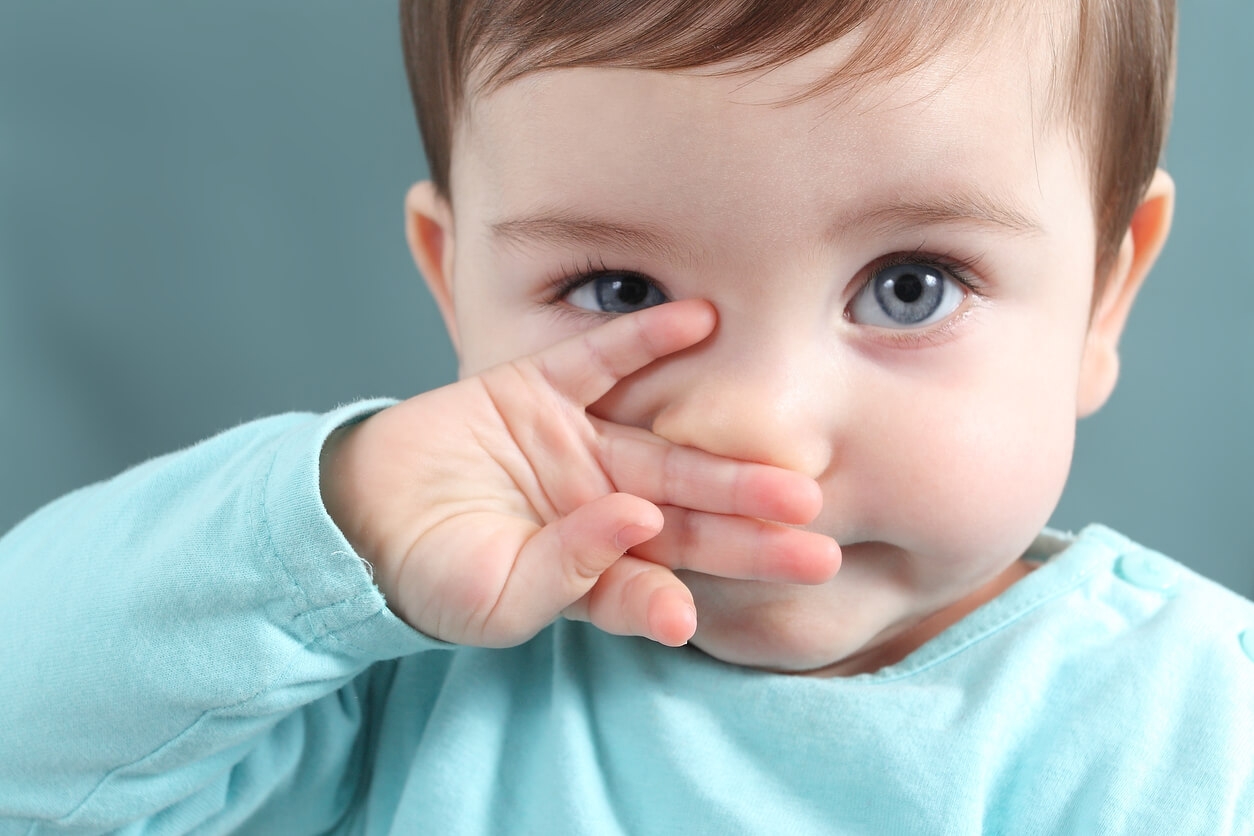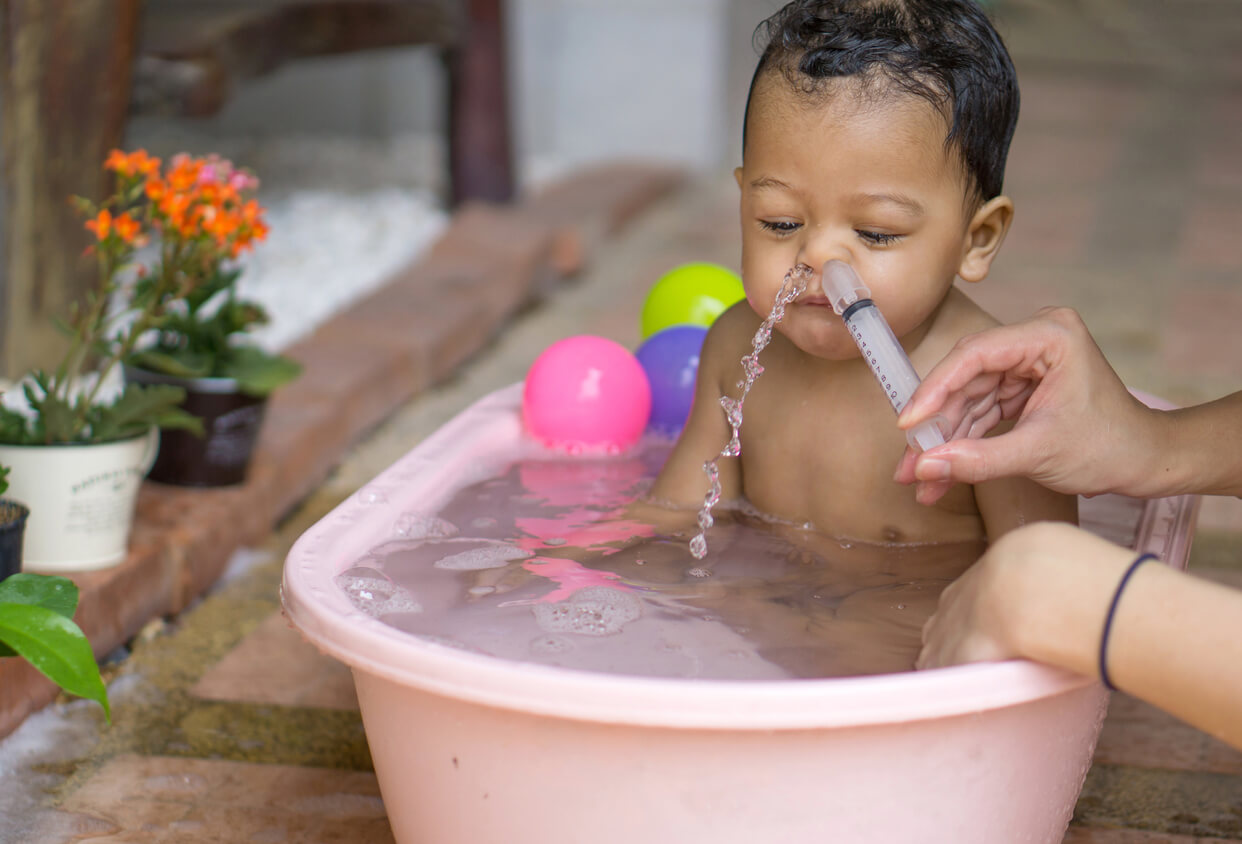My Baby Has Trouble Breathing Due to Snot: What to Do?


Written and verified by the nurse Leidy Mora Molina
One of the conditions that produce greater concern in parents is when their baby has a lot of snot, causing them to have trouble breathing. Their little one cries, gets irritated, and this increases their discomfort even more. But, what can you do in this situation? Can they choke on their own secretions? Keep reading to find out how to alleviate this symptom in your child.
Healthy children also get sick
During childhood, it’s common for children to suffer 10 to 12 colds a year, even the healthiest of them. This is a consequence of the immaturity of their immune system and, in a way, favors the development of the natural defenses they need to survive.
Consequently, you shouldn’t be alarmed if your child spends most of their childhood with snot running down their nose, as this is part of their growth process. In the following article, we’ll tell you why these secretions are produced and under what circumstances they increase a little more. We’ll also tell you what you can do if your child has trouble breathing due to nasal congestion.
Why is snot produced?
The production of nasal mucus arises as a defense mechanism of the body to clean the respiratory tract of viruses, bacteria, or external agents that try to enter.
In spite of this, it’s important to take into account that in small babies, an excessive production of mucus can significantly obstruct their respiratory tract and cause little ones to have trouble breathing. This is because the diameters of these ducts are still very narrow and in general, natural elimination mechanisms (such as coughing) aren’t as efficient at this age.
In addition to this, during the first months of life, babies don’t have the reflex to breathe through the mouth when their nose is blocked. Therefore, it’s difficult for them to get oxygen when they’re very congested.
Consequently, snot in babies produces a certain uneasiness, lack of appetite, and discomfort, which they’ll express through crying. This disturbing sensation of almost permanent suffocation makes them very irritable and produces great anguish in their parents.

The most frequent causes of increased mucus production
Snot in babies can be produced by several causes, among which we’ll highlight the following:
- Allergies
- Colds
- Sudden temperature changes
- The inhalation of irritating substances
- Continuous crying
- Very dry environments
It’s important to observe the characteristics of the baby’s mucus in order to approach the cause that produces them. In general, when they’re clear, white, and fluid, they usually respond to temperature changes or allergies. On the contrary, when they’re yellow, green, and thick, they usually indicate a respiratory infection.
The most advisable thing is that, in the presence of mucus in the small baby, you go to the pediatrician to be evaluated so they can indicate the most appropriate strategy to relieve the congestion.
What to do if the baby has a snotty nose and has trouble breathing?
If your baby has mucus, you must keep calm and look for a way to help them to expel it. There are different techniques to do it, and here we’re going to share with you those that are most recommended by specialists.
1. Nasal washes
Nasal washes are the first option to unclog the nasal passages of babies with snot. Through them, the mucous membranes are moisturized, the snot’s dissolved, and thus, it can be removed much easier from the nose.
To perform nasal washes, you should find a time when the baby’s calm, such as after bathing and before feeding or sleeping.
You should use a 0.9% sterile physiological solution at room temperature and help yourself with a small syringe to introduce this liquid into the baby’s nose. Take note of the following steps:
- Place the baby with their head on their side on the changing table and put a towel under their head.
- Hold them well to prevent them from moving.
- Gently place 2cc of saline solution in the upper nostril: This allows it to enter through one nostril and exit through the other, without passing into the ear or pharynx.
- Sit the child up so that the secretions are expelled.
- Then, turn the child to the other side and repeat this procedure in the other nostril.
- You can perform these washes as many times as necessary if the baby still has a blocked nose.
There are also special seawater sprays for babies or physiological saline solution in single doses for each wash available on the market. These make the procedure even easier.
It’s important to remember that the use of antihistamines and other drugs should only be administered under medical prescription.

2. Steam baths and the use of a humidifier
If the home environment’s dry, it’s best to have an air humidifier. This prevents the mucous membranes from drying out and, in turn, favors the production of the secretions necessary to fight germs. It’s not a good idea for this device to be left on in the baby’s room all night and during the day, as it’s important to ventilate the rooms well.
Similarly, steam baths are ideal to thin the mucus and soothe your baby. But these should be reserved for older children, as the excess of water in the respiratory tract of the little ones can be counterproductive.
Ideally, you should take advantage of bath time for your baby to inhale the small amount of steam contained in the bathroom.
3. The use of a nasal aspirator
Nasal aspirators are a tube with a bulb that helps to suck out the mucus to clear the nasal passages. To use one, you must press the bulb, insert the nozzle into the baby’s nostril and aspirate gently.
It’s not a good idea to use it excessively because apart from being an unpleasant practice for babies, it can cause lesions in the respiratory mucosa. Two aspirations per day are more than enough.
4. Hydration when your baby has trouble breathing due to snot
Keeping your baby hydrated is key to helping them eliminate mucus as water favors the fluidification of secretions and makes them easier to expel.
For this reason, it’s best to offer the baby breastfeeding on demand and, if the baby’s older than 6 months, in addition to milk, offer salt-free broths, soups, and plenty of water.
When to visit your pediatrician?
It’s important to visit a pediatrician whenever your child has mucus with any of the following symptoms or signs:
- A fever (temperature above 100.4ºF)
- A constant, dry, or productive cough
- Difficulty breathing, agitation, and sinking in the ribs or the hollow behind the clavicles when breathing
- Extreme lack of appetite, which doesn’t allow him to ingest sufficient liquids
- General malaise and decay
As long as the baby has mucus, it’s best to implement some of the above mentioned tips. Although they don’t cure illnesses or accelerate their resolution, they provide relief and comfort to little ones. This allows them to remain calm, well nourished and hydrated, and more rested as they recover.
One of the conditions that produce greater concern in parents is when their baby has a lot of snot, causing them to have trouble breathing. Their little one cries, gets irritated, and this increases their discomfort even more. But, what can you do in this situation? Can they choke on their own secretions? Keep reading to find out how to alleviate this symptom in your child.
Healthy children also get sick
During childhood, it’s common for children to suffer 10 to 12 colds a year, even the healthiest of them. This is a consequence of the immaturity of their immune system and, in a way, favors the development of the natural defenses they need to survive.
Consequently, you shouldn’t be alarmed if your child spends most of their childhood with snot running down their nose, as this is part of their growth process. In the following article, we’ll tell you why these secretions are produced and under what circumstances they increase a little more. We’ll also tell you what you can do if your child has trouble breathing due to nasal congestion.
Why is snot produced?
The production of nasal mucus arises as a defense mechanism of the body to clean the respiratory tract of viruses, bacteria, or external agents that try to enter.
In spite of this, it’s important to take into account that in small babies, an excessive production of mucus can significantly obstruct their respiratory tract and cause little ones to have trouble breathing. This is because the diameters of these ducts are still very narrow and in general, natural elimination mechanisms (such as coughing) aren’t as efficient at this age.
In addition to this, during the first months of life, babies don’t have the reflex to breathe through the mouth when their nose is blocked. Therefore, it’s difficult for them to get oxygen when they’re very congested.
Consequently, snot in babies produces a certain uneasiness, lack of appetite, and discomfort, which they’ll express through crying. This disturbing sensation of almost permanent suffocation makes them very irritable and produces great anguish in their parents.

The most frequent causes of increased mucus production
Snot in babies can be produced by several causes, among which we’ll highlight the following:
- Allergies
- Colds
- Sudden temperature changes
- The inhalation of irritating substances
- Continuous crying
- Very dry environments
It’s important to observe the characteristics of the baby’s mucus in order to approach the cause that produces them. In general, when they’re clear, white, and fluid, they usually respond to temperature changes or allergies. On the contrary, when they’re yellow, green, and thick, they usually indicate a respiratory infection.
The most advisable thing is that, in the presence of mucus in the small baby, you go to the pediatrician to be evaluated so they can indicate the most appropriate strategy to relieve the congestion.
What to do if the baby has a snotty nose and has trouble breathing?
If your baby has mucus, you must keep calm and look for a way to help them to expel it. There are different techniques to do it, and here we’re going to share with you those that are most recommended by specialists.
1. Nasal washes
Nasal washes are the first option to unclog the nasal passages of babies with snot. Through them, the mucous membranes are moisturized, the snot’s dissolved, and thus, it can be removed much easier from the nose.
To perform nasal washes, you should find a time when the baby’s calm, such as after bathing and before feeding or sleeping.
You should use a 0.9% sterile physiological solution at room temperature and help yourself with a small syringe to introduce this liquid into the baby’s nose. Take note of the following steps:
- Place the baby with their head on their side on the changing table and put a towel under their head.
- Hold them well to prevent them from moving.
- Gently place 2cc of saline solution in the upper nostril: This allows it to enter through one nostril and exit through the other, without passing into the ear or pharynx.
- Sit the child up so that the secretions are expelled.
- Then, turn the child to the other side and repeat this procedure in the other nostril.
- You can perform these washes as many times as necessary if the baby still has a blocked nose.
There are also special seawater sprays for babies or physiological saline solution in single doses for each wash available on the market. These make the procedure even easier.
It’s important to remember that the use of antihistamines and other drugs should only be administered under medical prescription.

2. Steam baths and the use of a humidifier
If the home environment’s dry, it’s best to have an air humidifier. This prevents the mucous membranes from drying out and, in turn, favors the production of the secretions necessary to fight germs. It’s not a good idea for this device to be left on in the baby’s room all night and during the day, as it’s important to ventilate the rooms well.
Similarly, steam baths are ideal to thin the mucus and soothe your baby. But these should be reserved for older children, as the excess of water in the respiratory tract of the little ones can be counterproductive.
Ideally, you should take advantage of bath time for your baby to inhale the small amount of steam contained in the bathroom.
3. The use of a nasal aspirator
Nasal aspirators are a tube with a bulb that helps to suck out the mucus to clear the nasal passages. To use one, you must press the bulb, insert the nozzle into the baby’s nostril and aspirate gently.
It’s not a good idea to use it excessively because apart from being an unpleasant practice for babies, it can cause lesions in the respiratory mucosa. Two aspirations per day are more than enough.
4. Hydration when your baby has trouble breathing due to snot
Keeping your baby hydrated is key to helping them eliminate mucus as water favors the fluidification of secretions and makes them easier to expel.
For this reason, it’s best to offer the baby breastfeeding on demand and, if the baby’s older than 6 months, in addition to milk, offer salt-free broths, soups, and plenty of water.
When to visit your pediatrician?
It’s important to visit a pediatrician whenever your child has mucus with any of the following symptoms or signs:
- A fever (temperature above 100.4ºF)
- A constant, dry, or productive cough
- Difficulty breathing, agitation, and sinking in the ribs or the hollow behind the clavicles when breathing
- Extreme lack of appetite, which doesn’t allow him to ingest sufficient liquids
- General malaise and decay
As long as the baby has mucus, it’s best to implement some of the above mentioned tips. Although they don’t cure illnesses or accelerate their resolution, they provide relief and comfort to little ones. This allows them to remain calm, well nourished and hydrated, and more rested as they recover.
All cited sources were thoroughly reviewed by our team to ensure their quality, reliability, currency, and validity. The bibliography of this article was considered reliable and of academic or scientific accuracy.
- De la flor, J. (2017). Infecciones de vías respiratorias altas-1: resfriado común. Pediatría Integral 2017; XXI (6): 377–398.
- Sociedad española de medicina de familia y comunitaria (2005) Mucosidades en el bebé y en el niño pequeño. Recuperado de: https://www.agamfec.com/pdf/2018/Unidad17.pdf.
- The Children’s Mercy Hospital (2020) Cómo usar un aspirador nasal manual. Recuperado de: https://www.childrensmercy.org/siteassets/media-documents-for-depts-section/documents-for-health-care-providers/evidence-based-practice/clinical-practice-guidelines–care-process-models/manual-nasal-aspirator-spanish.pdf.
This text is provided for informational purposes only and does not replace consultation with a professional. If in doubt, consult your specialist.








